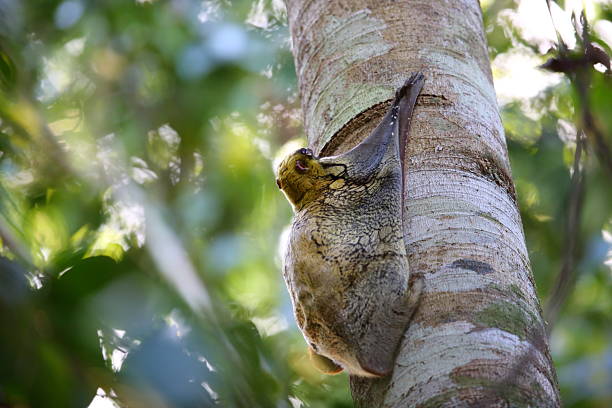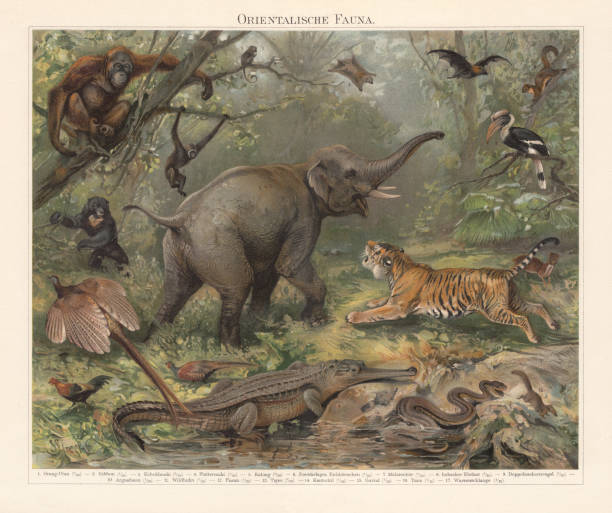
Colugo Pictures, Images and Stock Photos
Browse 190+ colugo stock photos and images available, or search for sunda colugo to find more great stock photos and pictures.

A Sunda flying lemur (Galeopterus variegatus) clings to a tree in the rainforests of Southeast Asia.
Flying Lemur (Galeopterus variegatus) flying from a tree to another tree, in Mu Ko Surin National Park, Thailand
Colugo or Flying Lemur found in the lowland forest and mangrove forests, Seen at the Kinabatangan river in Sabah, Malaysia
Sunda Flying Lemur (Cynocephalus variegatus) in Borneo
A Sunda flying lemur (Galeopterus variegatus) clings to a tree in the rainforests of Southeast Asia.
Colugo or Flying Lemur found in the lowland forest and mangrove forests, Seen at Danum valley feeding on sap of the tree. Sabah, Malaysia
Flying Lemur (Galeopterus variegatus) clings to a tree and rests during the day (nocturnal animal), in Mu Ko Surin National Park, Thailand
A Sunda Colugo (Galeopterus variegatus), AKA Sunda Flying Lemur, parent and a baby
Flying Lemur (Galeopterus variegatus) clings to a tree and rests during the day (nocturnal animal), in Mu Ko Surin National Park, Thailand
Colugo or Flying Lemur found in the lowland forest and mangrove forests, Seen at Bako Park in Sarawak, Malaysia
A curious baby Sunda Colugo peeking its head out of its mom's pouch to look at the big world around it
Flying Lemur (Galeopterus variegatus) clings to a tree and rests during the day (nocturnal animal), in Mu Ko Surin National Park, Thailand
Sunda flying lemur - Galeopterus variegatus or Sunda colugo or Malayan flying lemur or Malayan colugo, found throughout Southeast Asia in Indonesia, Thailand, Malaysia, and Singapore.
Colugo Animal also known as Sunda flying lemur or Sunda colugo or Malayan flying lemur
Colugo or Flying lemur
Asian wildlife: 1) Orang-Utan (Pongo); 2) Gibbon (Hylobatidae); 3) Tarsier (Tarsiidae); 4) Colugo (Dermoptera); 5) Large flying fox (Pteropus vampyrus); 6) Black giant squirrel (Ratufa bicolor); 7) Page semi-protected Sun bear (Helarctos malayanus); 8) Indian elephant (Elephas maximus indicus); 9) Great hornbill (Buceros bicornis); 10) Great argus (Argusianus argus); 11) Red junglefowl (Gallus gallus); 12) Common pheasant (Phasianus colchicus); 13) Tiger (Panthera tigris); 14) Lesser Malay chevrotain (Tragulus kanchil); 15) Gharial (Gavialis gangeticus); 16) Large treeshrew (Tupaia tana); 17) Elephant Trunk Snake (Acrochordus javanicus). Chromolithograph, published in 1897
The Flying Lemurs of Borneo are not related to the lemurs of Madagascar. They are unique and of the order Dermoptera meaning 'Skin -wings'. They can fly up to 100m. In trees they move slowly and during daylight sleep clinging to trunks in camaplage colour. This lemur has a black baby head peeping out.
A Sunda flying lemur (Galeopterus variegatus) clings to a tree in the rainforests of Southeast Asia.
Black and white illustration of educational counting game for children with cartoon wild animal characters group coloring book page
Bats (Chiroptera): a) Black-eared flying fox (Pteropus melanotus); b) Common vampire bat (Desmodus rotundus); c) Common noctule (Nyctalus noctula); d) Brown long-eared bat (Plecotus auritus); e) Greater horseshoe bat (Rhinolophus ferrumequinum); f) Sunda flying lemur (Galeopterus variegatus). Hand colored chromolithograph after a drawing by Christian Votteler (German illustrator, 1840 - 1916), published in 1869.
Also named Sanda flying lemur
Sunda flying lemur - Galeopterus variegatus or Sunda colugo or Malayan flying lemur or Malayan colugo, found throughout Southeast Asia in Indonesia, Thailand, Malaysia, and Singapore.
Flying Lemur (Galeopterus variegatus) clings to a tree and rests during the day (nocturnal animal), in Mu Ko Surin National Park, Thailand
Attached itself in a tree trunk. Nocturnal mammal
Sunda flying lemur - Galeopterus variegatus or Sunda colugo or Malayan flying lemur or Malayan colugo, found throughout Southeast Asia in Indonesia, Thailand, Malaysia, and Singapore.
Young colugo peeking out from under its mother's body, while hanging against a tree trunk. The image was taken in a rainforest in Singapore.
Black and white cartoon illustration of finding the right shadows to the pictures educational game for children with animal characters coloring book page
Cartoon illustration of finding the differences between pictures educational game for children with funny animal characters group
A Sunda flying lemur (Galeopterus variegatus) clings to a tree in the rainforests of Southeast Asia.
flying lemur with 2 baby's on her back balancing on a rope
Cartoon illustration of wild animal characters group coloring book page
Prosimians: Colugo (Galeopithecus rufus), Senegal bushbaby (Galago senegalensis), Mongoose lemur (Eulemur mongoz), Red slender loris (Loris tardigradus), Aye-Aye (Chiromys madagascariensis). Woodcut engraving, published in 1876.
Flying Lemur (Galeopterus variegatus) attached to a tree in a tropical forest in South East Asia.
Representatives of the Orders Chiroptera and Primates Engraving Antique Illustration, Published 1851. Source: Original edition from my own archives. Copyright has expired on this artwork. Digitally restored.
Illustration of educational counting game for children with cartoon wild animal characters group
Cartoon illustration of odd one out picture in a row educational task for children with comic animal characters
Cartoon illustration of educational jigsaw puzzle game for children with funny wild animal characters
Cartoon illustration of find one of a kind picture educational game with comic animal characters
Black and white cartoon illustration of funny wild animal species characters big set
On the tree,can gliding in the forest
A Sunda flying lemur (Galeopterus variegatus) clings to a tree in the rainforests of Southeast Asia.
Vintage color illustration - Sunda flying lemur, Sunda colugo, Malayan flying lemur or Malayan colugo (Galeopterus variegatus)
The Sunda flying lemur (Galeopterus variegatus), also known as the Malayan flying lemur or Malayan Colugo, is, presently, one of the only two species of flying lemurs in the world. Contrary to its name, it is not a lemur, neither can it fly. It has a gliding membrane connecting the neck and its upper body, called patagium, and uses this to glide from tree to tree. It is strictly arboreal and nocturnal, and its diet consists mainly of leaves, sap from plants, flower buds, nectars, fruits and shoots. It has no eyelids, hence sleeps in the daytime with its eyes seemingly wide open. This lemur was photographed on the island of Langkawi, Malaysia.
Rest on the tree,nearby the balcony of hotel The Andaman,langkawi,malaysia
View of The Bay of Kotor near Tivat town at sundown, Montenegro - Water landscape
Picturescue view of The Bay of Kotor near Tivat town at sundown, Montenegro - Water landscape
The Bay of Kotor near Tivat at sundown, Montenegro
On a big tree in Langkawi ,Malaysia
A Sunda or Malayan Colugo, Malayan Flying Lemur, clinging onto a tree trunk in a nature park. It is found in Southeast Asia — Indonesia, Thailand, Malaysia, and Singapore. Photographed in macritchie.
A Sunda or Malayan Colugo, Malayan Flying Lemur, clinging onto a tree trunk in a nature park. It is found in Southeast Asia — Indonesia, Thailand, Malaysia, and Singapore. Photographed in macritchie.
Colugo Animal also known as Sunda flying lemur or Sunda colugo or Malayan flying lemur


























































